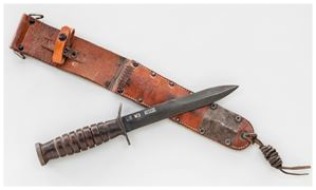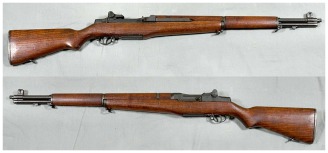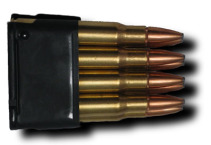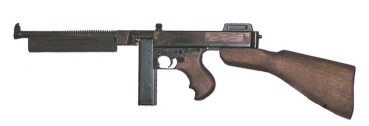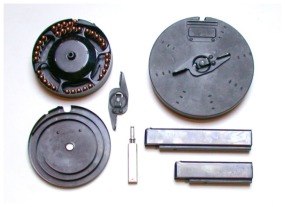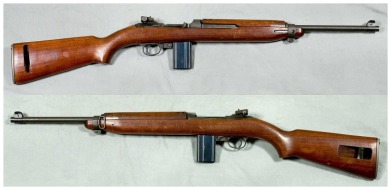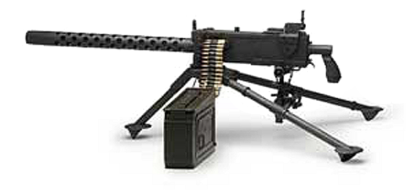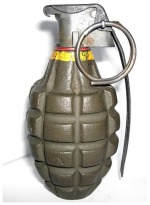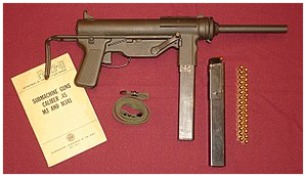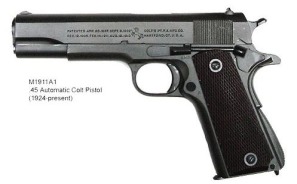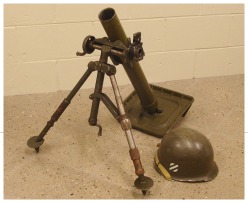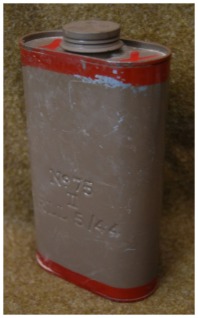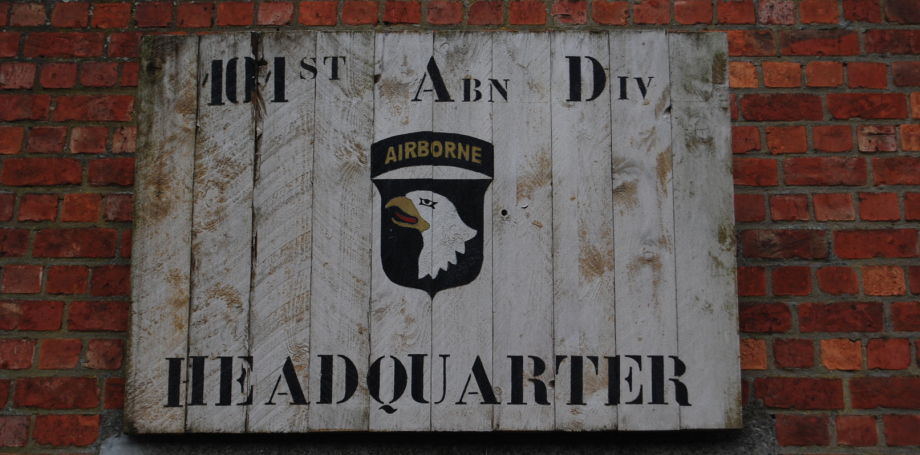
Information
Use the following links to navigate our Information pages:-
[Downloads Page] [Interesting Links Page] [Weapons] [Equipment] [Uniforms]
Weapons - 101st Airborne in WWII
A PDF download of the following information can also be found on our Downloads page
M3 Fighting Knife & M6 Scabbard
The M3 fighting knife was originally issued in March 1943 and designed primarily for use by ‘elite’ troops such as airborne and Army Rangers. The M3 was initially issued with a riveted leather M6 scabbard with a protective guard designed to prevent the point from piercing the sheath and injuring the wearer. US paratroopers frequently wore the M3 and M6 sheath tied to their boot for emergency use in cutting parachute lines or for close quarters defence.
M1 Garand
Officially designated "U.S. Rifle, Calibre 30, M1" - The M1 Garand is a .30 calibre semi-automatic rifle that was the standard U.S. service rifle during World War II. The M1 rifle was named after its Canadian/American designer, John Garand. It was the first standard issue semi-automatic military rifle and General George S. Patton called it "the greatest battle implement ever devised".
The M1 rifle is a gas-operated, 8 shot clip-fed, semi-automatic rifle. It is 43.6 inches (1,107 mm) long and it weighs about 9.5 pounds (4.31 kg). It has a maximum firing range of 500 yards (457m), though 300 yards (270m) was considered the effective norm for the combat soldier. The M1 Garand was designed for simple assembly and disassembly to facilitate field maintenance and can be field stripped (broken down) without tools in just a few seconds.
During World War II the M1 rifle's semi-automatic operation gave United States infantrymen a significant advantage in firepower and shot-to-shot recovery time over enemy infantrymen armed primarily with bolt-action rifles. The semi-automatic operation and reduced recoil allowed soldiers to fire 8 rounds as quickly as they could pull the trigger, without having to move their hands on the rifle and therefore disrupt their firing position and point of aim. The Garand's fire rate, in the hands of a trained soldier, averaged 40–50 accurate shots per minute.
Thompson Sub Machine Gun
One of the best-known firearms in recent history, the Thompson sub machine gun was invented in 1918 by American John T. Thompson, and became infamous during the Prohibition era. A favourite with soldiers, criminals, police, and civilians alike for its large .45 ACP cartridge, accuracy, and high volume of fully automatic fire, it became a common sight in the media of the time earning many nicknames - "Tommy Gun", "Annihilator", "Chicago Typewriter", "Chicago Piano", "Chicago Style", "Chicago Organ Grinder", "Trench Broom", "Trench Sweeper", "The Chopper", and simply "The Thompson".
Rather than working as a locked breech, it functioned as a friction-delayed blowback action and the .45 ACP round was the only cartridge, in U.S. service, suitable for use with the lock. The M1928A1 had provisions for box and drum magazines. It had a Cutts compensator, cooling fins on the barrel, and its charging/cocking handle was on the top of the receiver. The M1 and M1A1 had a barrel without cooling fins, a simplified rear sight, provisions only for box magazines, employed a straight blowback action and the charging/cocking handle was on the side of the receiver. The M1A1, standardized in October 1942, could be produced in half the time of the M1928A1, and at a much lower cost.
Lighter, more compact, quicker to change and less susceptible to rattle, Military users preferred the box magazines over the drum magazines. The one complaint, users had however of the twenty round box magazine, was it was limited in capacity so some soldiers taped two magazines together until in December 1941 when a 30 round box was introduced.
The Thompson was used in World War II in the hands of Allied troops as a weapon for scouts, non-commissioned officers (corporal, sergeant, and higher), and patrol leaders, as well as commissioned officers, tank crewmen, and soldiers performing raids on German positions. In the European theatre, the gun was widely utilized in British and Canadian commando units, as well as in the U.S. Army paratrooper and Ranger battalions, where it was issued more frequently than in line infantry units because of its high rate of fire and its stopping power, which made it very effective in the kinds of close combat these special operations troops were expected to undertake.
M1 Carbine
United States Carbine, Calibre .30, M1 - The M1 carbine is a lightweight, easy to use .30 calibre (7.62 mm) semi-automatic carbine that was a standard firearm for the U.S. military during World War II. Despite its name and similar appearance, the M1 carbine is not a shorter version of the M1 Garand rifle. It is a completely different firearm, and it fires a different type of ammunition. It was simply called a carbine because it is smaller and lighter than the Garand.
During WWII the M1 carbine with its reduced-power .30 cartridge was not originally intended to serve as a primary weapon for combat infantrymen, nor was it comparable to more powerful assault rifles developed later in the war. However, it was markedly superior to the .45-calibre sub machine guns in use at the time, in both accuracy and penetration, and its lighter .30 cartridge allowed soldiers to carry more ammunition. As a result, the carbine was soon widely issued to infantry officers, American paratroopers, NCOs, ammunition bearers, forward artillery observers, and other frontline troops. The first M1 carbines were delivered in mid-1942, with initial priority given to troops in the European Theatre of Operations.
M1919 Browning .30 Calibre Machine Gun
The M1919 Browning is a .30 calibre medium machine gun that was widely used during World War II. The M1919 saw service as a light infantry, coaxial, mounted, aircraft, and anti-aircraft machine gun by the U.S. and many other allied countries.
The M1919 fired the .30 calibre M2 ball cartridge, contained in a woven cloth belt, feeding from left to right. A metal M1 link was later adopted, forming a "disintegrating" belt. The gun's original design was as a water-cooled machine gun (like its WWI predecessor the M1917 Browning machine gun). When it was decided to try to lighten the gun and make it air-cooled, its design as a gun that fires from the closed bolt, created a potentially dangerous situation. If the gun was very hot from prolonged firing, the cartridge ready to be fired could be resting in a red hot barrel, causing the propellant in the cartridge to heat up to the point that it would ignite on its own without warning. With each further shot heating the barrel even more as this happened, the gun would continue to fire and become uncontrollable until the ammunition ran out, since the trigger was not what was causing the gun to fire in this situation. This is known as a cook-off, and was the reason gunners were taught to cock the gun with the palm facing up, so that in the event of a cook-off, their thumb wouldn't be dislocated by the reciprocating charge handle. Gunners were trained to manage the barrel heat by firing in controlled bursts of three to five rounds, with a delay between bursts to delay its heating.
The M1919 required at least a two-man machine gun team but in practice, three to four men were normally involved: the gunner (who fired the gun and when advancing carried the tripod and box of ammo), the assistant gunner (who helped feed the gun and carried it, and box of spare parts and tools), and one or two ammunition carriers.
Mk 2 "Pineapple" Hand Grenade
The Mk 2 grenade is a fragmentation type anti-personnel hand grenade introduced by the U.S. armed forces in 1918. It was the standard issue anti-personnel grenade used during World War II and in many historic photographs can be seen being carried by US airborne troops, on their combat uniform.
The Mk 2 was manufactured of cast iron with a grooved surface divided into 40 knobs in 5 rows of 8 columns. As well as providing extra grip, the grooves and knobs gave it the appearance of a pineapple, and are the origin of that nickname.
M3 Sub Machine Gun - "Grease Gun"
The M3 was an American .45-calibre sub machine gun adopted for U.S. Army service on 12 December 1942, as the United States Sub machine Gun, Cal. .45, M3. The M3 was chambered for the same .45 round fired by the Thompson submachine gun, but was cheaper to produce, and lighter. The M3 was commonly referred to as the "Grease Gun" or simply "the Greaser," owing to its visual similarity to the mechanic's tool. Intended as a replacement for the .45-calibre Thompson series of submachine guns, the M3 began to replace the Thompson in front-line service in mid-1944.
M1911 Pistol
Designed by John Browning, the M1911 is a single-action, semi-automatic, magazine-fed, recoil-operated pistol, chambered for the .45 ACP (Automatic Colt Pistol) cartridge. It served as the standard-issue sidearm for the United States Armed Forces from 1911 to 1986 and was widely used in World War I, World War II, the Korean War, and the Vietnam War.
Battlefield experience in World War I led to some more small external changes, completed in 1924. The new version received a modified type classification, M1911A1, in 1926 with a stipulation that M1911A1s should have serial numbers higher than 700,000 with lower serial numbers designated M1911. The M1911A1 changes to the original design consisted of a shorter trigger, cutouts in the frame behind the trigger, an arched mainspring housing, a longer grip safety spur (to prevent hammer bite), a wider front sight, a shortened hammer spur, and simplified grip checkering (eliminating the "Double Diamond" reliefs). New M1911A1 pistols were given a parkerized metal finish instead of blueing, and the wood grip panels were replaced with panels made of brown plastic.
M2 Mortar
The M2 Mortar is a 60 mm smoothbore, muzzle-loading, high-angle-of-fire weapon used by U.S. forces in World War II, for light infantry support.
The U.S. M2 60 mm mortar was developed from the heavier 81 mm M1 Mortar to provide a lighter-weight alternative and attempted to bridge the gap between the 81mm mortar and the hand grenade. It consists of a smoothbore metal tube on a rectangular baseplate, supported by a simple bipod with the elevation and traverse mechanisms. The firing pin was fixed in the base cap of the tube, and the bomb was fired automatically when it dropped down the barrel. Though classed as a light mortar, the M2 had considerable range (Maximum firing range of approx. 1.1miles) and its fixed-firing pin design allowed a high rate of fire by trained crews.
Hawkins Grenade / Mine
Designed by British born Captain Hawkins the anti-tank grenade/mine was introduced in 1942. It was used in WW2 by both the British Army and the US Airborne and is often seen strapped to the legs of the US paratroopers like the 101st Airborne and the 82nd Airborne Divisions.
The grenade is 7 inches (178 mm) x 3.75 inches (95 mm) x 2.75 (70 mm). Made of steel it weighed 3lb (1.36 kg). It contained 2lb (0.91 kg) of either ammonal or TNT explosive and required a pressure of 10lb (4.54 kg) to set it off. When a vehicle drove over the grenade, it cracked a chemical igniter and leaked acid onto a sensitive chemical, which detonated the explosive. Multiple grenades were often used to destroy tanks or disable their tracks, and the grenade could also be used as a demolition charge.
The grenade was designed so that it could either be thrown at a vehicle like an ordinary anti-tank grenade or used as an anti-tank mine. A number could be strung together in a 'daisy chain' at intervals of around two feet, and then placed across a road to damage an armoured vehicle. The Hawkins was also used in other roles, such as breaching walls. Its small size also meant that it could easily be placed into the 'web' of a railway line and when detonated could destroy a section of track.

